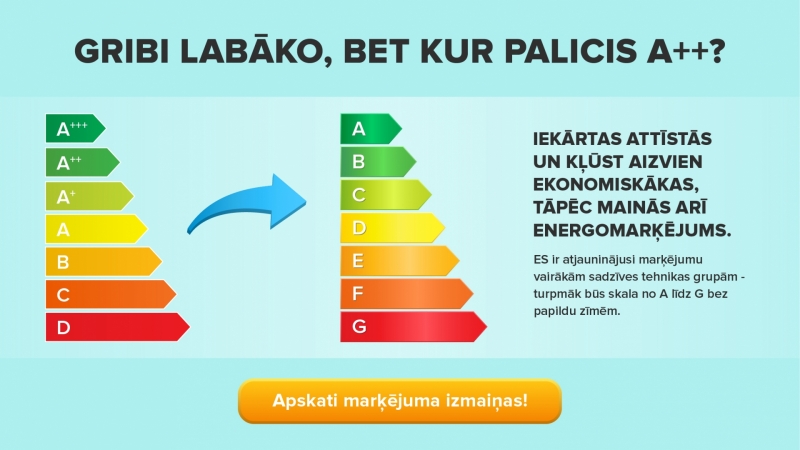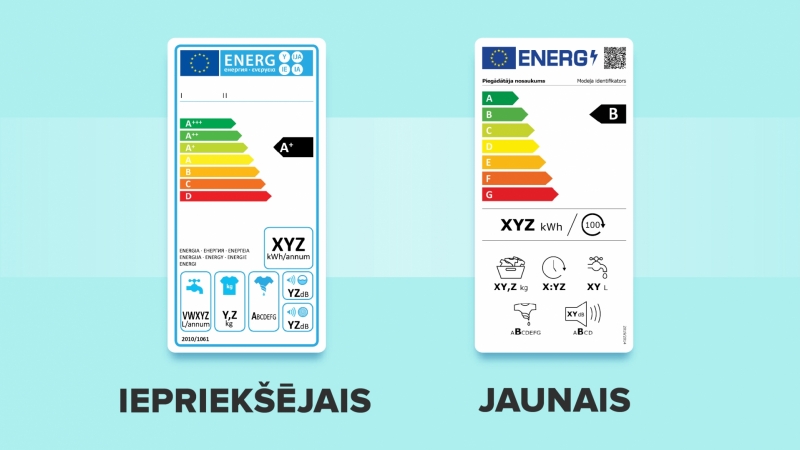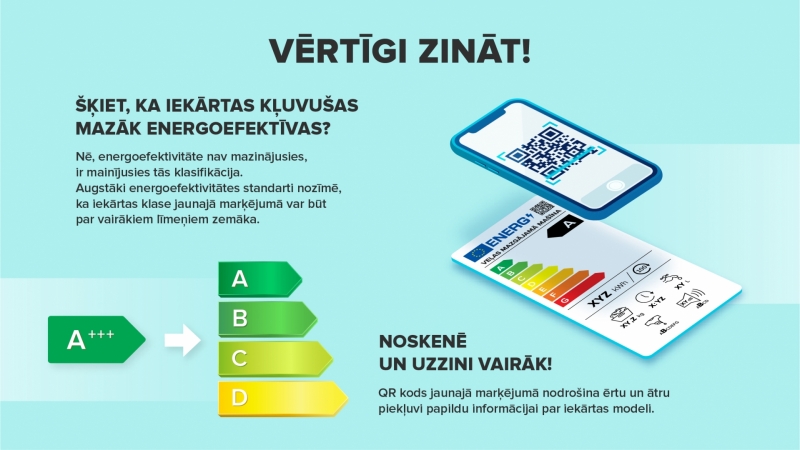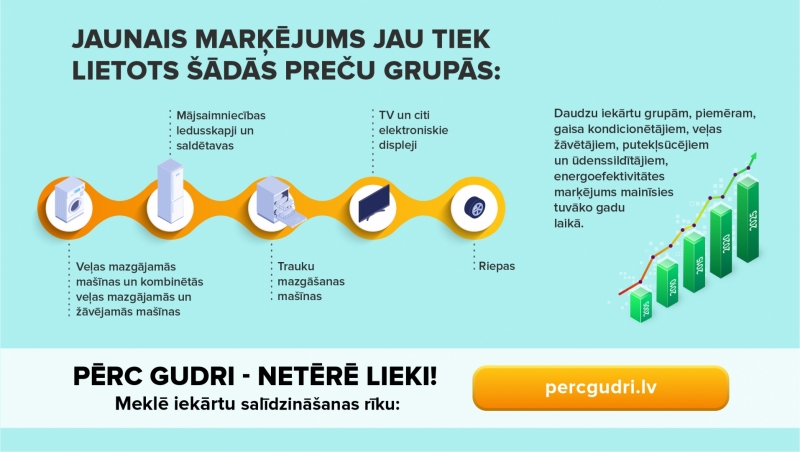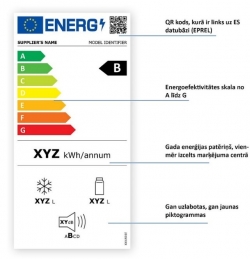The new energy label
A new energy label for 7 product groups has been created for 2021. The main changes are a new energy efficiency scale with classes A-G, the addition of a QR code and new icons for certain labels.
New energy labels for household fridges and freezers, washing machines, washer-dryers, dishwashers and TVs and other electronic displays are introduced from 1 March 2021. For light sources, a new energy label came into force on 1 September 2021, while for tyres the energy label came into force on 1 May 2021.
- The new label uses the same A-G scale for all products. The A++/A+ classes will no longer be used.
- A QR code with a link to the European Commission's labelling database EPREL has been introduced.
- The energy consumption of all products is indicated immediately below the energy efficiency scale.
- At the bottom of the label there are different pictograms informing about the characteristics of the selected product. Some of the pictograms are the same as before, but some have been improved or new ones developed.
- The new labelling requirements for TVs also apply to other screens, such as computer monitors. In addition, the label specifies the energy consumption per 1000 operating hours in SDR and HDR mode instead of the previous annual energy consumption.
- The energy label for washing machines indicates the energy consumption per 100 washing cycles instead of the current annual energy consumption.Lamps sold without a bulb are no longer required to display an energy label.
- The energy label on tyres will now include pictograms indicating that winter tyres are designed for use in particularly heavy snow or frost conditions. Only tyres that have undergone specific testing and meet the minimum requirements will display the icons on the label.
Implementation deadlines:
For product groups for which the new energy labelling requirements came into force on 1 March 2021, the new label and data sheet must be displayed on all products in both physical and online stores.
Products that were already on the market before 1 November 2020 but are either no longer on the market after 1 November 2020 or the supplier has gone out of business (so the new energy label has not been developed for the product) cannot be sold from 1 December 2021!
Time limits for the introduction of light sources:
For light sources placed on the market before 1 September 2021:
From 1.05.2021 - suppliers must register their product in the EPREL database based on the new Light Source Regulation (EU) 2019/2015, also register the renewed label and associated data sheet for products placed on the market earlier.
From 1.09.2021 to 28.02.2023 - in physical shops 18 months transition period. Products placed on the market before 1.09.2021 may be sold with the old or the new label. At the request of traders, suppliers must provide stickers with the updated label and data sheet for products in traders' stock and traders must replace the labels.
From 1.09.2021 to 20.09.2021 - 14 working days transition period for online shops. Traders selling luminaires on the internet must display the new label and data sheet on the product's website from 20 September 2021.
For light sources placed on the market after 1 September 2021:
From 1.09.2021 - the new label and data sheet must be provided.
From 1.03.2023 - all products have the new energy label and data sheet. All products must have the new energy label printed or stuck on, covering the old one. Only the new data sheets need to be attached.
Products may not be put up for sale under both the new and the old labels. Only one energy label may be displayed per product.
Displaying the energy label in-store and online
An energy label and a data sheet must be provided for all products subject to energy labelling requirements. A number of guidelines have been developed for the display of energy labels in shops and online shops
There are two ways to display the energy label and the data sheet on products on the internet:
The full energy label and the data sheet are displayed next to the product and its price in a legible size.
The energy label and data sheet are placed close to the price of the product.
The label and data sheet shall be of a size to be clearly visible and legible.
An arrow icon with the corresponding energy efficiency class and a link to the data sheet (nested visualisation) shall be placed next to the product price.
The icon includes the full energy label.
The energy efficiency class icon shall be placed next to the product price and the font size of the energy efficiency class shall be at least the same size as the font size of the price.
A link to the data sheet shall be clearly visible close to the price.
The full size of the label shall be displayed by hovering the cursor over the icon or by a single click, mouse scroll or touch screen zoom in the image.
The full-size data sheet appears by clicking with the mouse or by hovering over the link.
The arrow is in the colour of the corresponding energy efficiency class.
For products subject to the new energy labelling requirements, the nested visualisation shall use the energy efficiency class icon with the range of energy efficiency classes (A-G) indicated on the side of the arrow;
For products for which the new energy label has not been developed, the icon shall not include the class range.
If goods are sold online or remotely, e.g. by phone, the seller still has to provide information about the product, including the information contained in the energy label.
The obligation to display the energy label and the information sheet in an online shop applies not only to the product page of the shop, but also to other pages of the shop where the price of the product is indicated (e.g. a section showing all available dishwashers).
The energy efficiency class and class range must also be indicated in promotional material:
- an arrow with the corresponding letter in the size of the indicated price,
- an arrow in the colour of the corresponding energy efficiency class.
The above also applies to printed or electronic catalogues and brochures, where the consumer has the possibility to order the product by clicking on the product, calling or otherwise.
(For more information on the specific regulations governing the display of information when products are sold in shops or on the internet, see Ecodesign and energy labelling legislation.)
Energy labelled products
The Energy Label has been developed for 16 product groups. See below for the specific requirements for each product group.
EPREL
All products subject to energy labelling requirements must be registered in the EPREL database before being placed on the EU market. Registration in the EPREL database is ensured by the supplier of the goods, but the trader must check that the goods are registered before starting to sell them.
About the EPREL database
The database consists of a public part and a compliance part. The online portal to be set up will provide access to both parts.
- The compliance part requires the entry of technical documentation and declarations of conformity, and this information is accessible to market surveillance authorities, including PTAC.
- In the public part of the database, suppliers have to enter information on product models, their energy consumption and other relevant characteristics. By scanning the QR code on the product label, anyone can access this information about the product.
- By further developing and extending the functionality of the EPREL database, it is planned that citizens, traders, researchers and other interested parties will be able to access all public information on all registered equipment.
How can I access EPREL public information?
The new energy labels include a QR code which, when scanned, can be used to access product-specific information in the EPREL database. For more information, see the section on the new energy label.
Equipment registration in EPREL
EPREL was established under Regulation 2017/1369 of the European Parliament and of the Council* and from 1 January 2019, suppliers (manufacturers, importers or authorised representatives) must register all equipment requiring an energy label in this database before selling it on the EU market.
Products subject to the new energy label requirements shall be registered in the EPREL database in accordance with the new energy label requirements.
In order to register products in EPREL and to obtain more information about the system itself and the registration process, an EU user account must be created. This can be done here: https://webgate.ec.europa.eu/cas/login?loginRequestId=ECAS_LR-9160821-Jz...
Once registered, all users have access to the EPREL website - https://webgate.ec.europa.eu/fpfis/wikis/spaces/viewspace.action?key=EPREL
The EPREL website contains the EPREL user guidelines and comments section, as well as an email address for technical assistance if needed.
The EPREL database maintainer accepts no responsibility for the accuracy of the data entered. The supplier or manufacturer who enters the data into the system is fully responsible for the veracity and accuracy of the data entered.
* REGULATION (EU) 2017/1369 OF THE EUROPEAN PARLIAMENT AND OF THE COUNCIL (Article 4) https://eur-lex.europa.eu/legal-content/LV/TXT/PDF/?uri=CELEX:32017R1369...
The aspects of the EPREL database and the exact supplier rules are laid down in Commission Implementing Regulation (EU) 2024/994
Frequently asked questions
If you have any questions about ecodesign and energy labelling, you can consult PTAC staff using the contact details on the website. Before contacting us, we recommend you take a look at the Frequently Asked Questions, where you may already find the answer.
- Are energy labelling requirements only valid in Latvia?
The energy labelling requirements apply in all EU Member States and are the same in all countries. The Energy Label was first introduced in 1994. Over time, the number of products requiring labelling has increased.
- What are the main things to look out for when displaying an energy label in a shop?
When the energy label is displayed in the shop, it should be located on the front of the product or on the product where it is immediately visible to the customer. The energy label must be clearly legible and must not be damaged or obscured. For more information on the placement of the label in the shop, see the guidelines (link to guidelines).
- What are the main things to look out for when displaying the energy label and data sheet in an online shop?
In an online shop, the product must have both an energy label and a data sheet. Both should be close to the price.
An online shop can display both the full energy label and the data sheet, or use a nested visualisation where the energy label icon (arrow) and a link to the data sheet are next to the price. Clicking with the mouse on the icon and link should open the full energy label and data sheet.
The energy label and data sheet must be displayed in the online shop wherever the price of the product is indicated, i.e. not only on the product page itself, but also on the product group page (e.g. in the section where all refrigerators are located).
For more information on displaying the energy label online, see the guidelines. (link to the guidelines).
- Why is it not enough to add an energy label to the product images in an online shop?
Energy labelling legislation requires that the energy label is displayed next to the price of the product. If the energy label is only one of the images in the gallery, it is usually far away from the price. In addition, the image is reduced in size and is not immediately legible and understandable. It therefore does not meet the requirements of either the full label display (far from the price, you have to click on it to see the content) or the nested visualisation (no icon with a clearly visible energy efficiency class close to the price, which if clicked on would open the full label). In such cases, the data sheet, which provides additional information about the product, is also usually missing.
A correctly displayed energy label gives the buyer immediate information on the energy efficiency of the product as well as on the consumption of other resources. If it is added as one of the product images, it makes it more difficult to make an informed and sustainable decision.
- What is a data sheet and how is it different from a product description?
A datasheet is a standard document containing specific information about a product, provided to the trader by the supplier. It contains more detailed and precise information than a normal product description. The Energy Labelling Regulation includes a separate annex for each product group, which specifies exactly what information must be provided and in what order. For example, the data sheet for a washing machine includes the dimensions and rated capacity of the appliance as well as the washing efficiency index, programme duration, standby energy consumption, etc.
The customer is able to obtain additional information by comparing products on the same parameters, thus contributing to more informed decision-making. In addition, the buyer can consult the information he needs himself without burdening the seller with additional questions.
The description of the product is, on the other hand, freely chosen by the trader.
- Who and what goods should be registered in the EPREL database?
From 1 January 2019, suppliers (manufacturers, importers or authorised representatives) must register all equipment requiring an energy label in the EPREL database before selling it on the EU market.
Household appliances must be registered under the new requirements from 1 November 2020, and light sources must be registered under the new energy labelling requirements from 1 May 2021. Products that were already registered before the new energy labelling requirements came into force need to be re-registered.
- What should be done with goods that have the new energy labelling requirements in force but are in the trader's stock with the old label?
Household appliances for which the requirements came into force on 1 March 2021::
- Goods that continue to be placed on the market after the new requirements come into force are only marketed with the new energy label and data sheet from 18 March 2021.
- Goods must be registered (or re-registered) in the EPREL database in accordance with the new requirements.
For light sources placed on the market before 1 September 2021::
- From 1.05.2021 - suppliers must register their product in the EPREL database; they must also register the renewed labelling and the associated data sheet for products that have already been placed on the market.
- From 1.09.2021 to 28.02.2023 - 18 month transition period - goods placed on the market before 1.09.2021 can be sold with the old or the new label. Suppliers must provide labels with the updated label and data sheet for goods in their stock at the request of traders, and traders must replace the labels.
- Traders selling light sources on the internet must display the new label and data sheet on the product within 14 working days after 1 September 2021.
For all products: if the manufacturer has not provided the new energy labels and data sheets, traders must request them from their suppliers.
- How can an importer check that a product complies with EU ecodesign and energy labelling requirements?
Before importing goods, you need to make sure that the manufacturer is able to provide a declaration of conformity that includes references to all EU legislation that applies to the product (including the relevant Ecodesign Directive), as well as technical documentation. The declaration of conformity is defined in Directive 2009/125/EC of the European Parliament and of the Council.
In addition, from 1 January 2019, the supplier (manufacturer or importer) must enter information on all products subject to energy labelling requirements and placed on the market in the EU into the European Product Database for Energy Labelling (EPREL).
If the importer (supplier) does not have, or is unable to obtain, documents certifying that the product complies with EU legislation, it is prohibited to place the product on the EU market.
- Frequently asked questions on energy labelling published by the European Commission in English:



